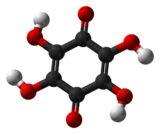Tetrahydroxy-1,4-benzoquinone
 | |
 | |
| Names | |
|---|---|
| IUPAC name
2,3,5,6-tetrahydroxycyclohexa-2,5-diene-1,4-dione | |
| Other names
Tetroquinone | |
| Identifiers | |
| 319-89-1 | |
| 3D model (Jmol) | Interactive image |
| ChemSpider | 5231 |
| ECHA InfoCard | 100.005.706 |
| |
| |
| Properties | |
| C6H4O6 | |
| Molar mass | 172.09 g·mol−1 |
| Appearance | Blue-black crystals |
| Density | 2.609 g/cm3 |
| Boiling point | 370.6 °C (699.1 °F; 643.8 K) at 760 mmHg |
| Slightly soluble in cold water | |
| Hazards | |
| Flash point | 192.1 °C (377.8 °F; 465.2 K) |
| Except where otherwise noted, data are given for materials in their standard state (at 25 °C [77 °F], 100 kPa). | |
| | |
| Infobox references | |
Tetrahydroxy-1,4-benzoquinone, also called tetrahydroxy-p-benzoquinone, tetrahydroxybenzoquinone, or tetrahydroxyquinone (THBQ, THQ), is an organic compound with formula C6O2(OH)4. Its molecular structure consists of a cyclohexadiene ring with four hydroxyl groups and two ketone groups in opposite (para) positions.
The compound gives a light red solution in water,[2] and crystallizes as the glistening bluish-black (but non-conducting) dihydrate C6O2(OH)4·2H2O.[2][3]
The compound can be synthesized from glyoxal[4] or from myo-inositol (phytic acid), a natural compound widely present in plants.[5] THBQ forms an adduct with 4,4'-bipyridine in the 2:3 ratio.[6]
Salts of THBQ
Like most phenols, THBQ is acidic and easily loses the four H+ ions from the hydroxyl groups, yielding anions such as C6H2O62− and C6O64−. The latter is symmetric and aromatic, as the double bonds and negative charges are evenly distributed over the six CO groups.
The calcium salt Ca2C6O6 is the dark purple pigment produced from inositol by Chromohalobacter beijerinckii in the fermentation of salt beans, already noted by T. Hof in 1935.[3][7][8][9][10]
The dark purple and insoluble dipotassium salt K2C6H2O6 was prepared by Preisler and Berger in 1942, by oxidizing inositol with nitric acid and reacting the result with potassium carbonate in the presence of oxygen. Reaction of this salt with hydrochloric acid affords THBQ in good yield.[11]
The black tetrapotassium salt K4C6O6 was prepared by West and Niu in 1962, by reacting THBQ with potassium methoxide in methanol. The salt is diamagnetic and the infrared spectrum suggests that the C-C and C-O distances are all equal, with the ring slightly distorted in the "chair" conformation.[12] Partial oxidation of K4C6O6 affords a green strongly paramagnetic solid, conjectured to be (K+)3 C6O63−, and complete oxidation yields potassium rhodizonate (K+)2 C6O62−.[12]
The greenish-black sodium salt Na4C6O6 was described by Fatiadi and Sanger in 1962.[4]
The dark-violet lithium salt Li4C6O6 has been proposed as an electrode material for batteries as it can be oxidized to the rhodizonate Li2C6O6 and reduced to the hexahydroxybenzene salt Li6C6O6.[5] In the absence of oxygen, Li4C6O6 is stable to about 450 °C and then decomposes leaving a residue of carbonate Li2CO3.[5] Indeed, the rhodizonate appears to disproportionate at about 400 °C into Li4C6O6 and cyclohexanehexone C6O6 that promptly decomposes to carbon monoxide, carbon dioxide, and carbon.[5] Li2C6O6 forms a hydrate Li4C6O6·2H2O that loses its water at about 250 °C.[5]
References
- ↑ Tetroquinone. The Merck Index, 11th Edition, 9177
- 1 2 Harold P. Klug (1965), The Crystal Structure of Tetrahydroxy-p-benzoquinone. Acta Crystallographica volume 19, pages 983-
- 1 2 Max W. Miller (1961), Microbial metabolites. McGraw-Hill
- 1 2 A. J. Fatiadi and W. F. Sanger (1962), Tetrahydroxyquinone. Organic Syntheses, Coll. Vol. 5, p.1011 (1973); Vol. 42, p.90 (1962)
- 1 2 3 4 5 Haiyan Chen, Michel Armand, Matthieu Courty, Meng Jiang, Clare P. Grey, Franck Dolhem, Jean-Marie Tarascon, and Philippe Poizot (2009), Lithium Salt of Tetrahydroxybenzoquinone: Toward the Development of a Sustainable Li-Ion Battery J. Am. Chem. Soc., 131 (25), pp. 8984–8988 doi:10.1021/ja9024897
- ↑ J. A. Cowan, J. A. K. Howard and M. A. Leech (2001), Interpenetrating supramolecular lattices in 4,4'-bipyridine-2,3,5,6-tetrahydroxy-1,4-benzoquinone (3/2). Acta Crystallographica Section C, Volume 57, Part 10 (October 2001), 1196-1198. doi:10.1107/S0108270101011647
- ↑ T. Hof (1935), Rec. Trav. Botan. Neerland. 32 92.
- ↑ A J Kluyver, T Hof, A G J Boezaardt (1939), On the Pigment of Pseudomonas Beijerinckii Hof [ = Chromohalobacter beijerinckii]
- ↑ (1945) Vitamins and Hormones: Advances in Research and Applications, vol. 3
- ↑ Leland Alfred Underkofler, Richard James Hickey (1954), Industrial fermentations
- ↑ Paul W. Preisler and Louis Berger (1942), Preparation of Tetrahydroxyquinone and Rhodizonic Acid Salts from the Product of the Oxidation of Inositol with Nitric Acid. Journal of the American Chemical Society, volume 64 issue 1, pp 67–69. doi:10.1021/ja01253a016
- 1 2 Robert West, Hsien Ying Niu (1962), Symmetrical Resonance Stabilized Anions, CnOn−m. II. K4C6O6 and Evidence for C6O6−3. J. American Chemical Society, volume 84, issue 7 (April 1962), pp 1324–1325. doi:10.1021/ja00866a068